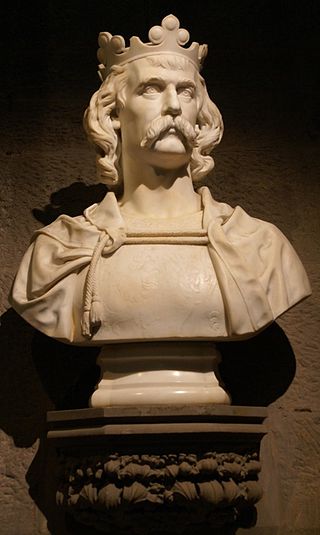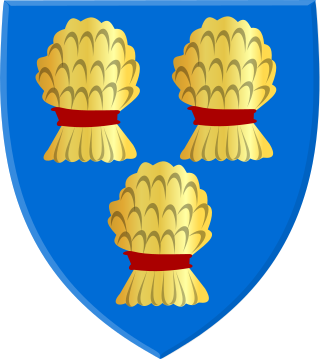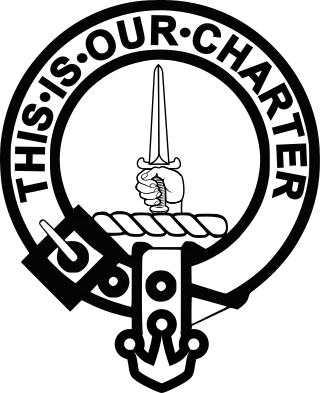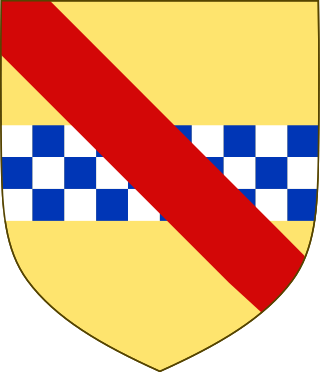Related Research Articles

Robert I, popularly known as Robert the Bruce, was King of Scots from 1306 to his death in 1329. Robert led Scotland during the First War of Scottish Independence against England. He fought successfully during his reign to restore Scotland to an independent kingdom and is regarded in Scotland as a national hero.

The Battle of Methven took place at Methven, Scotland on 19 June 1306, during the Wars of Scottish Independence. The battlefield was researched to be included in the Inventory of Historic Battlefields in Scotland and protected by Historic Scotland under the Scottish Historical Environment Policy of 2009, but was excluded due to the uncertainty of its location.

Earl of Carrick is the title applied to the ruler of Carrick, subsequently part of the Peerage of Scotland. The position came to be strongly associated with the Scottish crown when Robert the Bruce, who had inherited it from his maternal kin, became King of Scots in the early 14th century. Since the 15th century, the title of Earl of Carrick has automatically been held by the heir apparent to the throne, thus the current holder of the title is Prince William, Duke of Rothesay.

John Comyn III of Badenoch, nicknamed the Red, was a leading Scottish baron and magnate who played an important role in the First War of Scottish Independence. He served as Guardian of Scotland after the forced abdication of his uncle, King John Balliol, in 1296, and for a time commanded the defence of Scotland against English attacks. Comyn was stabbed to death by Robert the Bruce before the altar at the church of the Greyfriars at Dumfries, once it had been declared that Comyn had more connection to King David of Scotland and therefore should be the next King of Scotland, not Robert.

Marjorie Bruce or Marjorie de Brus was the eldest daughter of Robert the Bruce, King of Scots, and the only child born of his first marriage with Isabella of Mar.

Thomas Randolph, Earl of Moray was a soldier and diplomat in the Wars of Scottish Independence, who later served as regent of Scotland. He was a nephew of Robert the Bruce, who created him as the first earl of Moray. He was known for successfully capturing Edinburgh Castle from the English, and he was one of the signatories of the Declaration of Arbroath.
Marjorie of Carrick was Countess of Carrick, Scotland, from 1256 to 1292, and is notable as the mother of Robert the Bruce.
Robert de Brus, 6th Lord of Annandale, jure uxoris Earl of Carrick (1252–1292), Lord of Hartness, Writtle and Hatfield Broad Oak, was a cross-border lord, and participant of the Second Barons' War, Ninth Crusade, Welsh Wars, and First War of Scottish Independence, as well as father to the future king of Scotland Robert the Bruce.

Clan Charteris is a Scottish clan of the Scottish Lowlands.

Clan Seton is a Scottish clan which does not currently have a chief; therefore, it is considered an armigerous clan.

Clan Logan is a very ancient Scottish clan of Celtic origin. Two distinct branches of Clan Logan exist: the Highland branch; and the Lowland branch. The clan does not have a chief recognised by Lord Lyon King of Arms, and therefore can be considered an armigerous clan.
Christian or Christina Bruce, also known as Christian or Christina de Brus, was a daughter of Marjorie, Countess of Carrick, and her husband, Robert de Brus, jure uxoris Earl of Carrick, as well as a sister of Robert the Bruce, King of Scots. It is presumed that she and her siblings were born at Turnberry Castle in Carrick.
Sir David II Strathbogie was Earl of Atholl, Constable of Scotland, and Chief Warden of Northumberland.
John of Strathbogie was warden and Justiciary of Scotland.
Sir Andrew Murray (1298–1338), also known as Sir Andrew Moray, or Sir Andrew de Moray, was a Scottish military and political leader who supported King David II of Scotland against Edward Balliol and King Edward III of England during the Second War of Scottish Independence. He held the lordships of Avoch and Petty in north Scotland, and Bothwell in west-central Scotland. In 1326 he married Christina Bruce, a sister of King Robert I of Scotland. Murray was twice chosen as Guardian of Scotland, first in 1332, and again from 1335 on his return to Scotland after his release from captivity in England. He held the guardianship until his death in 1338.

Sir John Stewart, the brother of Sir James the 5th High Steward of Scotland, was a Scottish knight and military commander during the First Scottish War of Independence.
Dungal MacDouall was a fourteenth-century Scottish nobleman, and a member of the MacDouall family. He was a vigorous opponent of Robert I, King of Scotland during the First War of Scottish Independence, and was knighted by Edward I, King of England for his services to the English Crown. Dungal was a close associate of John MacDougall, Lord of Argyll, who he may have regarded as a kinsman. Dungal received grants of lands in England and Ireland after losing his own in Scotland. During his career, Dungal commanded Dumfries Castle and Rushen Castle, and is described by a contemporary record as "Captain of the army of Galloway". Dungal had a large family, and was succeeded by his son, Duncan.
Sir Christopher Seton (1278–1306), also known as Christopher de Seton, was a 13th-century noble, who held lands in England and Scotland. He was a supporter of Robert the Bruce and obtained Robert's sister's hand in marriage. Present during the killing of John Comyn, Lord of Badenoch at Greyfriars Church, Dumfries, he also killed Sir Robert Comyn, who had rushed to Badenoch's aid. Seton was captured at Loch Doon Castle and executed at Dumfries in 1306.
Events from the year 1306 in the Kingdom of Scotland.
Sir John de Seton was a knight who took part in the First War of Scottish Independence as a supporter of Robert de Brus. He held lands in England and Scotland.
References
- Bain, Joseph (1881). Calendar of documents relating to Scotland preserved in Her Majesty's Public Record Office, Volume 2. London: Public Record Office. ISBN 978-0852245392.